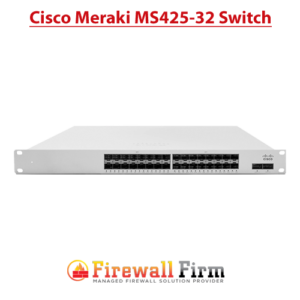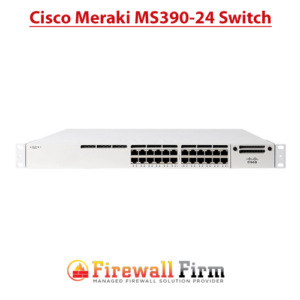Description
Overview:
Cloud-Managed Stackable Access Switches
Cisco Meraki MS210 switches provide Layer 2 access switching for branch and small campus locations. The MS210 includes 4 x 1G SFP uplinks and physically stacks with the MS225 to gain access to its 10G uplink. This family also supports an optional, rack-mountable PSU (Cisco RPS-2300) for power redundancy requirements
Cisco Meraki switches are built from the ground up to be easy to manage without compromising any of the power and flexibility traditionally found in enterprise-class switches.
The Meraki MS is managed through an elegant, intuitive cloud interface, rather than a cryptic command line. To bring up a Meraki switch, just plug it in; there’s no need for complicated configuration files or even direct physical access to the switch.
Meraki’s centralized management gives administrators deep visibility into the network and how it’s used. See which switches are near capacity across hundreds of sites. Find all configuration changes made by a certain person with instant search.
Industry Leading Cloud Management
Cloud management has a number of benefits that make it easier to build networks large and small:
- True zero-touch device provisioning.
- Virtual stacking: manage up to thousands of ports from a single pane of glass.
- Application layer visibility with automatic operating system, client, and hostname fingerprinting.
- Powerful Live Tools such as packet capture and cable test to isolate and troubleshoot network issues.
- Alerts upon power loss, downtime, or configuration changes.
- Role-based administration and automatic, scheduled firmware upgrades over the web.
- Regular feature updates and enhancements delivered on demand from the Meraki cloud.
MS210-24 Highlights
- Access to 10G uplink by physically stacking with the MS225
- Gigabit Access switching with 24 and 48 port models and optional PoE+
- 4 x 1G SFP uplink interfaces on all models
- Built-in dual stacking interfaces with up to 80G bandwidth
- Non-blocking switch backplane with up to 176 Gbps bandwidth support
- Up to 740 watt PoE budget with PoE+ support and dynamic power allocation for powering APs, phones, cameras, and other PoE-enabled devices
- 6 dedicated QoS queues for converged voice, video, and data applications
- Low power consumption and shallow rack depth options, enabling flexible deployment in wiring closets as well as offices and classrooms
- Integrated mounting brackets for rack and desk mounting
- Lifetime hardware warranty and advanced replacement at no additional cost
Specifications:
- Interfaces
- 24 × 10/100/1000BASE-T Ethernet (RJ45) with auto-MDIX crossover
- 802.3af/802.3at Power-over-Ethernet (PoE/PoE+) on MS210-24P, available on all ports (maximum of 30W per port for PoE+)
- 4 × 1GbE SFP interfaces for uplink
- 2 × Stacking interfaces
- Auto negotiation and crossover detection
- Management
- Managed via the cloud using the Meraki dashboard
- Integrated with Meraki Wireless and complete portfolio of IT products and solutions
- No-touch remote deployment (no staging needed)
- Detailed historical per-port and per-client usage statistics
- DHCP, client, and hostname fingerprinting
- SNMPd and SYSLOG support for integration with other network management solutions
- Seamless over-the-web firmware upgrades with scheduling & control
- Remote diagnostics
- Email, SMS and Mobile push notification alerts
- Cable testing and link failure detection with alerting
- Live remote packet capture
- Dynamic and interactive network discovery and topology
- Aggregated event logs with instant search
- Flexible stacking
- Physical stacking of up to 8 switches with 80 Gbps stack bandwidth on all models
- Virtual stacking supports thousands of switch ports in a single logical stack for unified management, monitoring, and configuration
- Ethernet switching capabilities
- 802.1p Quality of Service prioritization
- 802.1Q VLAN tagging with 4,095 addressable tags
- 802.1w, 802.1D Rapid Spanning Tree Protocol (RSTP, STP)
- Broadcast storm control
- 802.1ab Link Layer Discovery Protocol (LLDP) and Cisco Discovery Protocol (CDP)
- 802.3ad link aggregation with up to 8 ports per aggregate, Multichassis aggregates supported on stacked switches
- IGMP snooping for multicast filtering
- MAC forwarding entries: 16K on 24-port models, 32K on 48-port models
- Security
- Integrated two-factor authentication for Dashboard management
- Role-based access control (RBAC) with granular device and configuration control
- Corporate wide password policy enforcement
- IEEE 802.1X RADIUS, hybrid authentication and RADIUS server testing
- MAC-based RADIUS authentication (MAB)
- Port security: Sticky MAC, MAC whitelisting
- DHCP snooping, detection and blocking
- STP Enhancements: BPDU guard, Root guard
- IPv4 ACLs
- Power over Ethernet:
- 802.3af (PoE) 15.4 W per port and 802.3at (PoE+) 30 W per port
- Maximum PoE output (24P): 370 W
- PoE available on all ports simultaneously
- Performance
- Non-blocking switching fabric
- Switching capacity: 128Gbps (24-port models), 176Gbps (48-port models)
- Forwarding rate (mpps): 41.67 (24-port models), 77.38 (48-port models)
- Jumbo Frame Support (9578 byte Ethernet frame)
- Flow control support
- Layer 3
- Static Routing (maximum of 16 static routes supported)
- DHCP Relay
- Power
- Power input: 100 – 240 VAC, 47-63 Hz
- Power consumption: 15 – 448 W
- RPS interface: Requires RPS-2300 chassis, see Cisco RPS-2300 Datasheet for further information
- Mounting
- 1U Rack-mountable with included rack mount hardware
- 2-post front mounting options available
- Desktop-mountable with included feet
- Environment
- Operating temperature: 32°F to 104°F (0°C to 40°C)
- Humidity: 5 to 95% non-condensing
- MS225-24, MS225-48 feature fanless operation
- Regulatory
- CSA-US (US, Canada)
- FCC (USA)
- IC (Canada)
- CE (Europe)
- RCM (Australia/New Zealand)
- RoHS
- Warranty
- Full lifetime hardware warranty with next-day advanced replacement included
- MTBF at 25°C
- MS210-24: 590,165
- MS210-24P: 391,648
- Physical dimensions (H×W×D)
- MS210-24: 1.72 x 19.08 x 9.84″(4.38 x 48.46 x 25cm)
- MS210-24P: 1.72 x 19.08 x 9.84″(4.38 x 48.46 x 25cm)
- Physical Weight
- MS210-24: 6.03 lb (2.73 kg)
- MS210-24P: 8.18 lb (3.71 kg)
Features:
Meraki switches include all of the traditional Ethernet features found in modern enterprise access switches, including:
Campus Access
- Physical stacking with support for up to 8 stack members for built-in redundancy and performance
- Static and dynamic routing support with DHCP relay and server capabilities
- Quality-of-Service (QoS) to prioritize mission critical traffic such as voice and video
- Voice VLAN support for simplified VoIP deployments
- CDP, LLDP advertisement and snooping, with detailed neighbor visibility
- Port Mirroring to monitor network traffic
- IGMP Snooping to optimize network performance for multicast applications
- Link Aggregation Control Protocol (LACP) for high-capacity trunking, with Multichassis (MLAG) support on stacked switches
Network Security
- IEEE 802.1X, MAB, and Hybrid authentication support for wired access control with RADIUS server monitoring
- Port security and MAC whitelisting
- Change of Authorization (CoA) and RADIUS accounting support
- DHCP snooping to prevent users from adding unauthorized DHCP servers on the network
- Rapid spanning tree, BPDU guard, root guard, and other safeguards to help prevent misconfigurations and reduce convergence time
- Per port VLAN configuration
- Multiple administrative roles with sophisticated security policy management
Network Troubleshooting & Automation
- Virtual Stacking lets administators manage up to thousands of ports in a single interface without having to physically connect stack members
- Configuration templates for rapid, zero-touch provisioning and auditing of all sites
- Network Topology for automatic and interactive network mapping
- Remote cable testing, packet capture and client discovery
- Automatic and scheduled firmware upgrades for the complete network
Converged Voice, Video and Data Environments
The Meraki switch family is designed to unify data, voice, and video onto a single IP backbone. All Meraki switches support rich qualityof-service (QoS) functionality for prioritizing data, voice, and video traffic. The switches support eight class-of-service (CoS) queues on every port, enabling them to maintain end-to-end traffic prioritization.
PoE models provide power VoIP telephones, IP security cameras, wireless access points (APs), and other IP devices. In addition, using CDP and LLDP, PoE power is intelligently budgeted to maximize the number of PoE clients supported. For the most power-hungry applications, support for Cisco UPoE is also available. The Meraki MC products work flawlessly with Meraki switches, and create a unique and powerful experience to installing, supporting and troubleshooting VoIP technology
Application Layer Visibility
Meraki is the only switch to include integrated Layer 7 fingerprinting. Identify hundreds of applications from business apps to BitTorrent and YouTube. User fingerprinting with Google-like search allows administrators to easily identify and control individual users, PCs, iMacs, iPads, Androids, and other devices. This unprecedented visibility allows optimizing of network resources and maintaining optimal network performance.
Unified Software Architecture
Meraki switches run the same Meraki operating system used by all of Meraki’s products. The use of a common operating system allows Meraki to deliver a consistent experience across all product lines. When connected, MS250 switches automatically connect to the Meraki cloud, download configuration, and join the appropriate network. If new firmware is required, this is retireved by the switch and updated automatically. This ensures the network is kept up-todate with bug fixes, security updates, and new features.
Enterprise-class hardware
Meraki switches feature high-end hardware and an exceptional feature set, including:
- Options for fixed and modular uplinks: 1 GbE, 10 GbE, and 40 GbE uplink ports for high-speed connectivity to aggregation-layer switches or other upstream devices
- Optional multigigabit ports providing up to 10 Gbps on a single cable, supporting the latest Wi-Fi performance capabilities
- Wire-speed, non-blocking switch fabric (up to 800 Gbps), and six dedicated QoS queues for high-performance, converged voice, video, and data deployments
- Power-efficient, quiet acoustic designs and shallow rack-depth options enable flexible deployment in wiring closets as well as offices and classrooms
- Fanless design on select models
- Power over Ethernet, PoE+, and UPoE options available
- Up to 740W PoE budget with PoE+ support for powering APs, phones, cameras, and other PoE-enabled devices (124W for 120-8 series), with 830W available on the MS390 UPoE model
- Lifetime hardware warranty and advanced replacement at no additional cost
- Field-replaceable, hot-swappable power supplies and fans; RPS option for missioncritical applications; stack power on select models for added resilience
Powerful feature set for deployments of all types
Meraki switches include all of the traditional Ethernet features found on the highest-end
products, including:
• Quality-of-service (QoS) to prioritize mission-critical traffic such as voice and video
• IEEE 802.1x support for port-based network access control
• MAC-based RADIUS auth and MAC allowlisting
• Voice VLAN support for simplified VoIP deployments
• Port mirroring support for monitoring network traffic at line rate
• DHCP snooping to prevent users from adding unauthorized DHCP
servers on the network
• IGMP snooping to optimize network performance with multicast traffic
• Link aggregation control protocol (LACP) for high-capacity trunking, stacking,
and increased availability
• Rapid spanning tree protocol (RSTP), BPDU guard, root guard, and other safeguards
to help prevent misconfigurations and reduce convergence time
• Per port VLAN configuration
• Multiple administrative roles with sophisticated security policy management
• High-performance layer 3 routing capabilities on select models
Buy Cisco Meraki Switch online from Firewall Firm’s IT Monteur Store
 Firewall Security Company India Complete Firewall Security Solutions Provider Company in India
Firewall Security Company India Complete Firewall Security Solutions Provider Company in India















